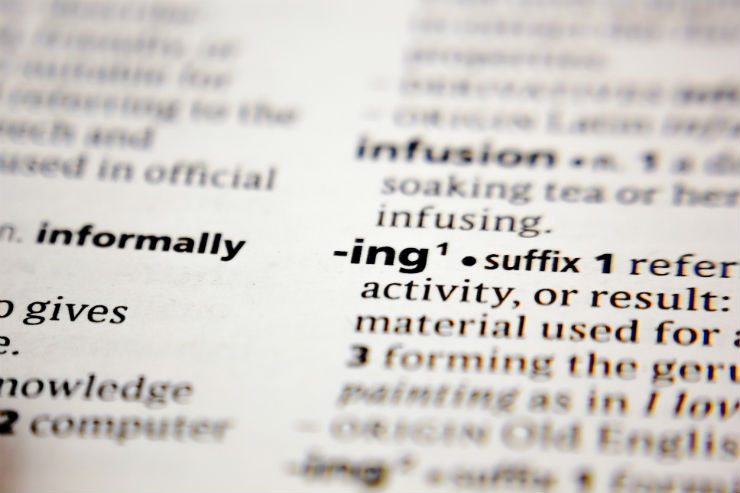What is the Italian gerund?
Italian gerund is the Italian equivalent of English verbs that end in –ing. Some uses are similar to the English gerund, some are not. In this article we’ll learn how to conjugate it and everything you need to know to use the Italian gerund like a native speaker.
The Italian gerundio is a mood which is easy to recognize: it ends either with –ando or –endo.
Before learning how to conjugate both regular and irregular verbs, let’s see some examples. The Italian Gerund is mostly used to express the idea of contemporaneity between two actions, or to form the present progressive:
Andando a lavoro, ho avuto un incidente con la macchina
While I was going to work, I had a car accident
Rientrando a casa, ho sentito puzza di fumo
While I was entering home, I smelled smoke
Che stai facendo? Sto studiando per l’esame
What are you doing? I’m studying for my exam
The Italian gerundio is an indefinite mode, meaning that it does not provide any indications on the subject (io, tu, loro…) of the action.

How to make the Italian gerund
There are two forms of gerundio: simple gerund and compound gerund. Sometimes they are also called present and past gerund. However, these two definitions can be tricky, as sometimes the so-called present gerund is used to talk about past sentences. For instance:
Andando all’aeroporto, mi accorsi che non avevo il passaporto
While going to the airport, I realized I didn’t have my passport
Let’s now see how simple and compound gerundio are formed in Italian.
Italian Gerund – Gerundio Presente
Forming the simple gerundio of regular Italian verbs is really easy: you just add the suffix –ando to the stem of -are verbs and the suffix –endo to the stem of –ere and –ire verbs:
–ARE
- andare (to go): andando
- guardare (to look): guardando
- cercare (to look for): cercando
-ERE
- vedere (to see): vedendo
- avere (to have): avendo
- leggere (to read): leggendo
-IRE
- dormire (to sleep): dormendo
- partire (to leave): partendo
- capire (to understand): capendo
For instance:
Ascoltando, forse capiresti i suoi bisogni
By listening, perhaps you’ll understand his needs
È dimagrita mangiando solo frutta e verdure
She lost weight by just eating fruit and vegetables
Crescendo, capirai cosa intendo
Growing up, you’ll understand what I mean
Italian Gerund – Irregular Verbs
Some irregular verbs do not follow this rule. You still have to add –ando or –endo, but the root of the verb will change.
Normally you add the conjugation suffix to the infinitive root of the verb, after removing –are, -ere or –ire, but with the verbs bere (to drink), fare (to do) and dire (to say) you will add the suffix to the first person singular in the Present indicative. For instance:
| Verb (infinitive form) | Present Indicative | Simple Gerund |
| Bere | Bevo | Bevendo |
| Fare | Faccio | Facendo |
| Dire | Dico | Dicendo |
Note that all the verbs related to fare, for instance disfare (to undo) and rifare (to do again) follow the same pattern as the source verb, so you’ll get rifacendo and disfacendo.
Rifacendo i conti, ho capito che avevo sbagliato
When doing the math again, I realized I did it wrong
Disfacendo la valigia, mi sono accorta di aver dimenticato lo spazzolino
While unpacking, I realized I forgot my toothbrush
Similarly, all the verbs related to dire will follow the same rule. For instance, disdire (to cancel) and contraddire (to contradict) will become disdicendo and contraddicendo.
Disdicendo all’ultimo minuto, non avrete indietro i soldi della prenotazione
By canceling at the last moment, you won’t have the reservation deposit returned
Cosa speri di ottenere, contraddicendo sempre l’insegnante?
What do you hope to obtain, by always contradicting the teacher?
Italian Gerund – Gerundio Passato
The compound tense is formed by the auxiliary verbs essere or avere conjugated in the Present Gerund + the past participle of the verb. For instance:
- andare (to go): essendo andato
- guardare (to look): avendo guardato
- cercare (to look for): avendo cercato
- vedere (to see): avendo visto
- leggere (to read): avendo letto
- dormire (to sleep): avendo dormito
- partire (to leave): essendo partito
- capire (to understand): avendo capito
Note that, with the auxiliary essere, the past participle must agree in gender and number with the subject of the verb, exactly like it happens for passato prossimo or any other compound verb.
Avendo visto quel film, conosceva già la trama
Having seen that movie, she already knew the plot
Essendo partiti all’improvviso, non hanno avuto tempo di salutare nessuno
Having left suddenly, they didn’t have the time to say goodbye to anyone
Avendo dormito fino a mezzogiorno, non ho sentito il telefono squillare
Having slept until noon, I didn’t hear the phone ringing
When to use the Italian gerund – 8 cases
Now that you know how to conjugate the gerundio, let’s see all the cases where it is used.
1. To indicate the way or method used to let something happened
È dimagrito facendo molto sport
He lost weight by doing a lot of sport
Lavorando sodo, ha ottenuto una promozione
Working hard (having worked hard), he got a promotion
2. To indicate the cause or reason why something happened
Non avendo contanti, ho pagato con la carta di credito
Not having cash (because I didn’t have cash), I paid by credit card
Essendo stata malata, non è andata a lavoro per una settimana
Being sick (since she was sick) she didn’t go to work for a week.
3. To express a condition
Studiando, si arriva lontano
By studying (If you study), you’ll go a long way
Ascoltando i miei consigli, otterrai quello che vuoi
By listening (If you listen) to my advices, you’ll get what you want
4. To express contemporaneity between two actions
Andando al supermercato, ho incontrato Marco
While going to the supermarket, I met Marco
Dicendo quelle parole, si rese conto che suonavano false
While saying those words, he realized they sounded fake
5. To express a concession
Pur non avendo fame, accettai di cenare con lei
Although I was not hungry, I accepted to have dinner with her
Pur avendo sbagliato, non vuole riconoscere l’errore
Despite having made a mistake, he doesn’t want to admit it
Pur essendo stanco, devo finire di studiare
Despite being tired, I need to finish studying
In this case, you need to add “pur” (despite, although) in front of the gerund.
As you may have noticed, in all the sentences above the subject in the main clause and in the subordinate clause is always the same person. In fact, when there are different subjects, Italian speakers do not use gerundio. For instance:
Mentre andavo al supermercato, Luca mi ha chiamata sul cellulare
While I was going to the supermarket, Luca gave me a phone call
6. Italian Gerund – Present Progressive
Like the English Present Continuous, the Present Progressive is used to talk about an action happening at the same time we are speaking.
In combination with the verb stare (to stay), that works as an auxiliary, the simple gerund can express the progression of an action in the same moment it is happening.
Here’s how to form the present progressive with stare:
| Subject | STARE (to stay) Indicative Present |
GERUND SIMPLE |
| Io | sto |
andando (to go) -ARE leggendo (to read) -ERE dormendo (to sleep) -IRE |
| Tu | stai | |
| Lui/lei | sta | |
| Noi | stiamo | |
| Voi | state | |
| Loro | stanno |
Che stai facendo? Sto cenando
What are you doing? I’m having dinner
Maria sta dormendo
Maria is sleeping
Il treno sta partendo, se non corriamo lo perderemo
The train is leaving, if we don’t run, we’ll miss it
Che stai leggendo ultimamente?
What are you reading, lately?
Non sento cosa stai dicendo, la musica è troppo alta
I can’t hear what you’re saying, the music is too loud
7. Italian Gerund – Past Progressive
You can use the verb stare in the Indicative present tense, to express that something is happening in the moment when you are speaking.
However, you can also use stare in the Indicative Imperfect tense, to form the Past Progressive and talk about an action that was going on in the past.
| STARE (to stay) Indicative Imperfect |
GERUND SIMPLE |
|
| Io | stavo | andando (to go) -ARE
leggendo (to read) -ERE dormendo (to sleep) -IRE |
| Tu | stavi | |
| Lui/lei | stava | |
| Noi | stavamo | |
| Voi | stavate | |
| Loro | stavano |
Che stavi facendo ieri pomeriggio? Ti ho chiamato ma non mi hai risposto
What were you doing yesterday afternoon? I called you but you didn’t answer
Stavo dormendo, quando ha squillato il telefono
I was sleeping when the phone rang
Il cane stava passeggiando nel parco
The dog was strolling around the park
Stavate vedendo un film?
Were you watching a movie?
Quando sono tornata a casa ieri, i bambini stavano litigando di nuovo
When I came back home yesterday, the children were fighting again
The Past Progressive is used to express an action in progress in the past. In this case, you can use both the Imperfect Indicative or the construction stare + Gerund:
Mentre stavo studiando, Luca stava dormendo
Mentre studiavo, Luca dormiva
While I was studying, Luca was sleeping
Note that when you use stare + Simple Gerund (both in the present or imperfect progressive) the subjects in the main and subordinate clause can be different. For instance:
Io stavo uscendo e tu stavi entrando
I was going out and you were coming in
Stavo andando a lavoro quando Francesca mi ha telefonato
I was going to work when Francesca called me
Mio fratello sta studiando e io sto guardando la tv
My brother is studying and I am watching TV
8. The verb Andare + Gerund
There is another use of the gerund: together with the verb andare(to go), it is used to express a progressive action, which develops during a period of time. Let’s make some examples to clarify it:
Il rumore andava crescendo mentre mi avvicinavo all’appartamento dei vicini
The noise became louder and louder as I was approaching my neighbors’ apartment
Luca va raccontando a tutti storie inventate
Luca is (going around) telling invented stories to everybody
Andare + gerundio is used to express an action happening in an indefinite time: it started sometime in the past, it’s still going on and will probably continue in the future.
What is the difference between andare + gerund and stare + gerund?
With andare, the action is incremental during time. Also, stare can be used as an auxiliary for all action verbs, while andare can only accompany few of them, for instance: dire (to say), raccontare (to tell), crescere (to grow), diffondere (to spread).
- Durante l’incendio, il fumo si andava diffondendo ovunque
During the fire, the smoke was spreading everywhere
- Ma che vai dicendo!
What the heck are you saying (going around and saying)!
| STARE (to stay) Indicative present |
GERUND SIMPLE | |
| Io | vado |
raccontando (to read) -ARE crescendo (to grow) -ERE dicendo (to say) -IRE |
| Tu | vai | |
| Lui/lei | va | |
| Noi | andiamo | |
| Voi | andate | |
| Loro | vanno |
| STARE (to stay) Indicative present |
GERUND SIMPLE | |
| Io | andavo |
raccontando (to read) -ARE crescendo (to grow) -ERE dicendo (to say) -IRE |
| Tu | andavi | |
| Lui/lei | andava | |
| Noi | andavamo | |
| Voi | andavate | |
| Loro | andavano |
When not to use the Italian gerund: differences with English
In Italian, gerundio is used differently from English. For instance, in English the -ing form can follow other verbs other than stare or andare as we saw; however, the Italian gerundio has no such use.
- He started shouting – Ha iniziato a gridare
- She quit smoking – Ha smesso di fumare
- I love eating pizza – Amo mangiare la pizza
When English uses the -ing form, Italian replaces it with a construction made with the verb + preposition (if needed) + the infinitive verb.
Future Actions
Do not use the Italian gerund to express a future planned action like in English. For instance:
Andrò in Italia l’anno prossimo!
I’m going to Italy next year
Faccio una passeggiata questo pomeriggio
I’m taking a walk this afternoon
As you can see in Italian you will have to use the future tense or the present tense if it’s made clear that the action is referring to the future.
To be + verb in the -ing form
Another example is the English construction to be + verb in the -ing form. For instance: to be sitting, to be lying. In these cases, The Italian uses the infinitive of the auxiliary + the past participle of the verb:
- To be sitting – Essere seduto
- To be lying – Essere disteso
Habitual actions in the past
Please note that the Imperfect Progressive cannot be used to express habitual actions in the past, like you would do with the Imperfect Indicative. If you want to talk about something that happened in the past on a regular basis or talk about a habit, you must use the Indicative Imperfect tense.
Da piccolo andavo a scuola in bicicletta
When I was young, I used to go to school by bike
Quando vivevo a Parigi, vedevo la Tour Eiffel ogni giorno
When I was living in Paris, I used to see the Tour Eiffel every day
Italian gerund and pronouns: where to put them
When there is a pronoun, for instance in case of reflexive or pronominal verbs, or if there are direct objects or indirect objects pronouns, you simply put them at the end of the gerund verb, like this:
Pettinandomi i capelli, ne ho trovato uno grigio
While combing my hair, I found a grey one
Avendoli visti cantare, posso dire che sono davvero bravi
Having seen them singing, I can say they’re really good.
Portandogli il caffè, sono caduta
While bringing him coffee, I fell down
When stare is used as an auxiliary, the pronouns precede the auxiliary. For instance:
- Gli sto portando il caffè – I’m bringing him coffee
- Li sto vedendo cantare – I’m watching them singing
- Mi sto pettinando i capelli – I’m combing my hair
Conclusion
Congratulations! You’ve come at the end of this long guide and so far you have everything you need to start using the Italian gerundio confidently.
Happy studying!






